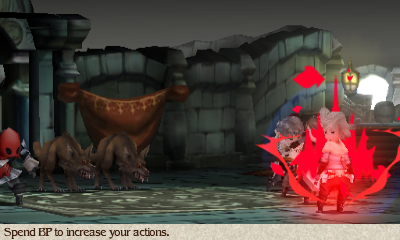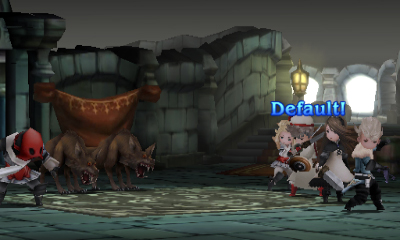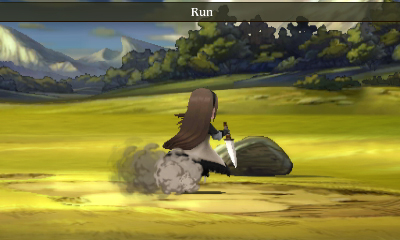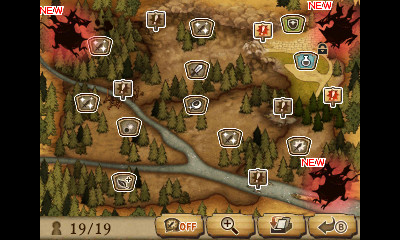A JRPG with a surprising twist.
To brave, or to default? This awkwardly worded question is what defines the core experience of Bravely Default, and a lot more than one would expect. Out of mere curiosity, I checked out the newly released Bravely Default demo on Friday, which is now available on the 3DS eShop.
Bravely Default in a turn-based JRPG in the style of Final Fantasy: The 4 Heroes of Light. The demo opens in a town that is about to be overrun by monsters, and your job is to complete a set of missions to free them from the imminent calamity. The demo itself is a separate side-story not found in the full game, though certain things like items are transferable.
Though at first I was expecting to control the game in a full 3D world, it came as a surprise when the first area opened as a 2D plane. Do not be fooled, however; despite being viewed from a 2D angle, the town is actually built in 3D, as you can traverse in and out of it in three dimensions. It is an interesting design choice, and one that does not really change the core of what Bravely Default is about, but it is still interesting nonetheless.
Outside of the opening town, the game allows players to explore a relatively small overworld and three separate dungeons, each with its own theme. Like its spiritual predecessor (and most Japanese RPG’s, for that matter), battles begin via random encounters, which is a trope that I seriously wish would go away in our medium. I do not see the point in them, and they only make things more frustrating when all you desire is to traverse from one location to another. But I digress.

To Brave...
Perhaps you are wondering where the “brave” and “default” elements come in. Despite the confusing terminology, they are a prevalent part of Bravely Default’s battle system. Though it took me a while to understand fully how to use them, it all comes down to using and storing battle points. If a character uses “default,” he or she does nothing for that turn, though defense in temporarily spiked and he or she accrues a battle point. At any given turn, a character can “brave” up to four times, meaning they get to perform up to four actions in that turn. But “brave” also comes at a cost; using “brave” will cause the character to lose a battle point, and negative battle points will render the character unusable for the next turn until the points are gained back – one per enemy turn.
It sounds like a relatively basic concept, but “brave” and “default” drastically changes the way you play. In the first few minutes of my playtime, I was unaware of how “brave” and “default” worked, and thus I battled on without them. Obviously, it was a struggle; I had to return to the town inn almost every time I finished battle.

... or to Default?
However, using “brave” and “default” changed my fortunes in ways that I could never have imagined. Because you are in control of four separate characters in battle, the key to using “brave” and “default” is to allocate each character’s battle points so that you will have at least one character active for the next turn. At the start of every battle, I would usually “brave” my first character four times and defaulting the other three so I could get a better understanding of how much damage my opponent could deal. I would then carry out a series of attacks, keeping sure that I had at least one character with positive battle points just in case all goes to hell and I can either heal another character or run away.
How important these strategies are became especially apparent when I encountered my first boss enemy. At first, I was sure I would not be able to defeat her; I had dealt less than 300 points of damage out of her 1200, and half of my heroes were already dead. However, though some careful planning and a little bit of luck, I was able to “brave” and “default” my way through the rest of the battle and managed to defeat the boss with ample health remaining in both of my characters. It was an exhilarating and satisfying endeavor, especially considering, unlike many other JRPG’s, the victory was a direct result of player input.

Knowing when to run is also a good strategy.
It is not all flowers and rainbows, however. Playing through the game felt like grind; after playing through an hour and a half, I managed to complete only three missions, which is a bit ridiculous if you ask me. The game suffers from pacing problems, an issue that has plagued the genre since its early conception. The game assures me that missions will work differently in the main game, but obviously, I have no way to gauge that myself, and I am certainly not willing to shell out forty bucks just to test it out.
Also included in the demo is the StreetPass side game that allows players to rebuild a town and receive items periodically in return. Additionally, I was able to play around with the AR “cut scenes,” which felt a bit strange given the little context I had for them. Neither feature was anything to write home about, but they are in included in the demo for those interested.

It is basically FarmVille on 3DS. Nothing to see here...
Personally, I am in no rush to go out and preorder Bravely Default, though after playing the demo I now have a much better understanding of what the game is about – and what the title actually means. I do applaud this game for trying something new and succeeding in changing the way players experience turn-based battles, which is definitely not something I expected going into the demo. Perhaps one day I shall find this flying fairy in the palm of my hands, but until then I will continue to enjoy the ever-growing library of my Nintendo 3DS.
Bravely Default is out in Japan and Europe now, and in North America on February 7th. The demo is available for download on the 3DS eShop.
![Amazing Spider-Man Finale Features New [SPOILER] Costume](../../../../../../assets1.ignimgs.com/2018/06/01/untitled-br-1527892808294_small.jpg)